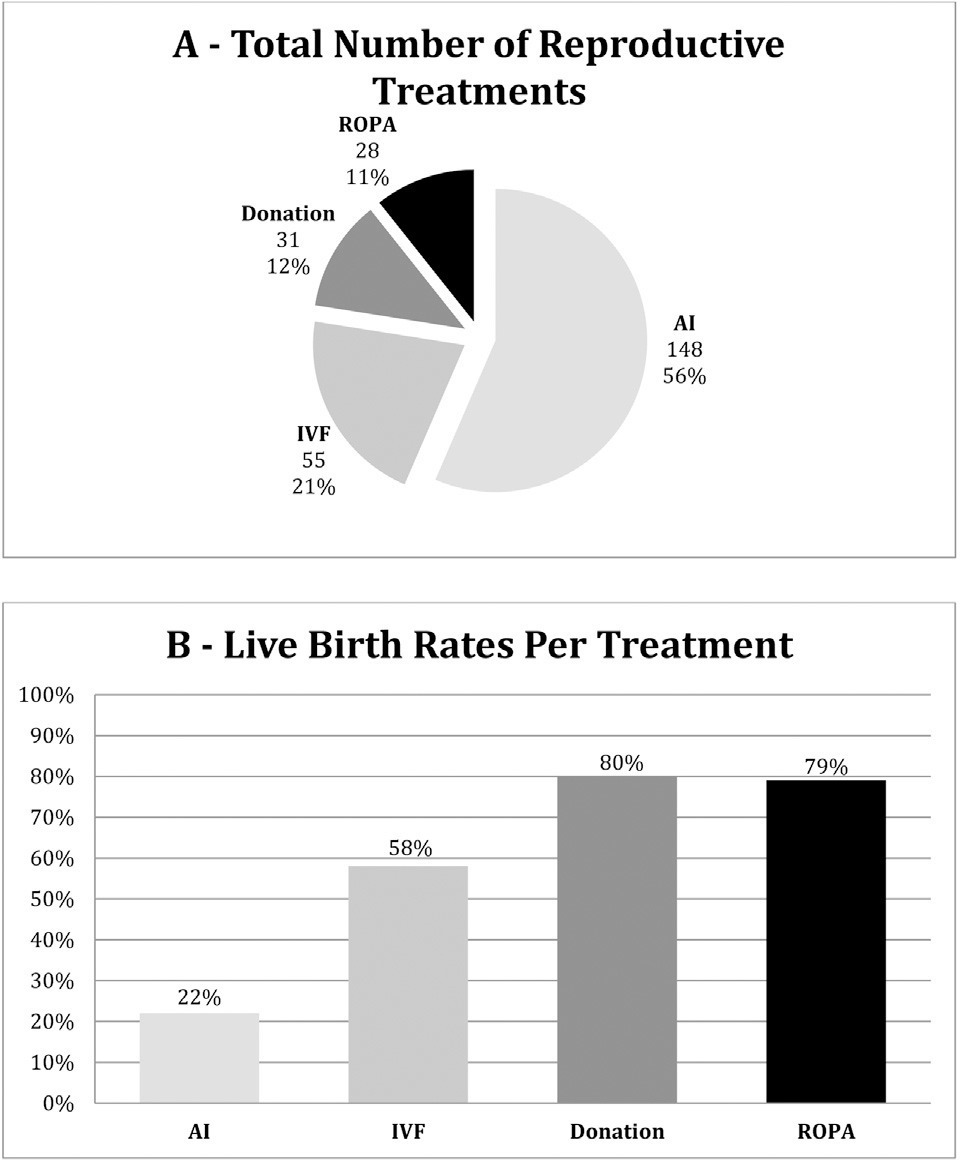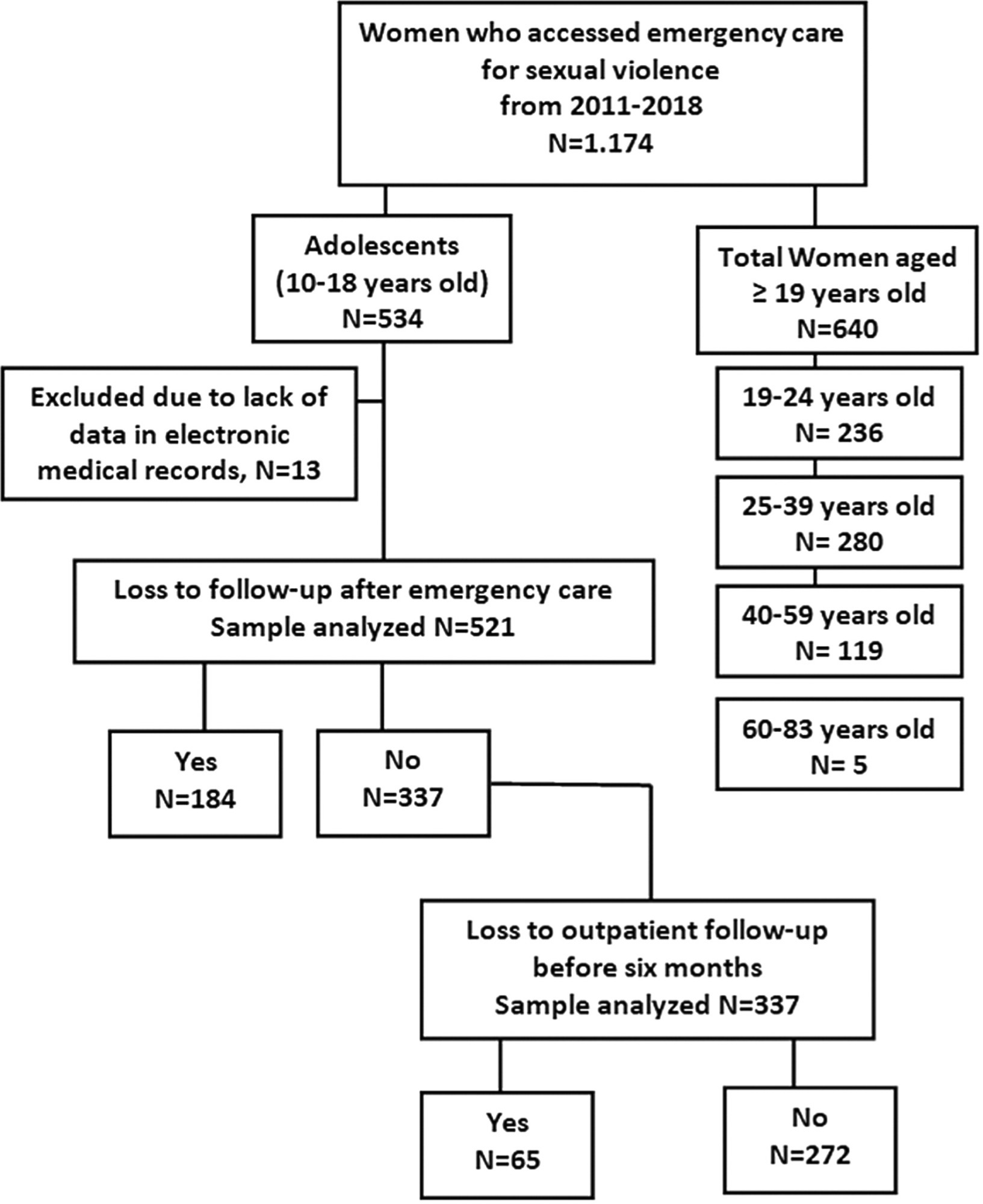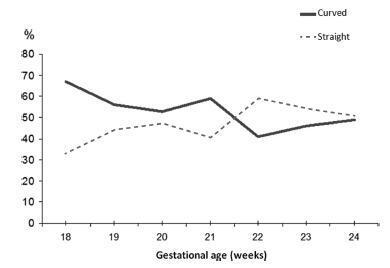Summary
Revista Brasileira de Ginecologia e Obstetrícia. 2022;44(7):660-666
The present study aims to describe the main characteristics of female couples resorting to a fertility clinic, to understand whether these patients have clear previous plans concerning procreation and how they end up completing their family planning, and to briefly describe the main outcomes of the recepción de ovocitos de pareja (ROPA, in the Spanish acronym: in English, reception of partner's oocytes) method.
This is a descriptive retrospective study of the pathway and outcomes of female couples in a fertility clinic during a 2-year period.
A total of 129 couples were treated. Only one third of the couples had no condition potentially affecting fertility or advanced age. Most couples were decided to undergo artificial insemination or in vitro fertilization and the majority kept their plans, as opposed to 38% of the couples who decided to the ROPA method (lesbian shared in vitro fertilization) who changed plans. Live birth rates per treatment (including frozen embryo transfers) for artificial insemination, 58% for in vitro fertilization, 80% for treatments with donated oocytes or embryos, and 79% for ROPA. Four in five couples achieved live births.
The present study highlights the importance of a thorough medical workup in same-sex couples resorting to assisted reproduction. Despite the higher-than-expected rates of fertility disorders, the outcomes were good. Most couples end up in a single parented method. Furthermore, the results of the ROPA method are reassuring.

Summary
Revista Brasileira de Ginecologia e Obstetrícia. 2023;45(11):661-675
To assess the loss to follow-up after emergency care and during 6-months of outpatient follow-up, and the associated variables, among adolescent sexual violence survivors.
This is a retrospective study with review of the medical records of 521 females, aged 10 to 18 years, who received emergency care in a referral service in São Paulo, Brazil. The variables were sociodemographic; personal history; characteristics of abuse, disclosure, and reactions triggered after abuse (physical and mental disorders as well as social changes), psychotropic prescription needs, and moment of abandonment: after emergency care and before completing 6 months of outpatient follow-up. To compare groups of patients lost to follow-up at each time point, we used the Chi-square and Fisher exact tests followed by multiple logistic regression with stepwise criterion for selection of associated variables. We calculated the odds ratio with confidence interval (OR, CI 95%). The level of significance adopted was 5%.
A total of 249/521 (47.7%) adolescents discontinued follow-up, 184 (35.3%) after emergency care and 65 (12.4%) before completing outpatient follow-up. The variables of living with a partner (OR = 5.94 [CI 95%; 2.49–14.20]); not having a religion (OR = 2.38 [CI 95%;1.29–4.38)]), having a Catholic religion [OR = 2.11 (CI 95%; 1.17–3.78)]; and not disclosing the abuse [OR = 2.07 (CI 95%; 1.25–3.44)] were associated with loss to follow-up after emergency care. Not needing mental disorder care (OR = 2.72 [CI 95%; 1.36–5.46]) or social support (OR = 2.33 [CI 95%; 1.09–4.99]) were directly associated with loss to outpatient follow-up.
Measures to improve adherence to follow-up should be aimed at adolescents who live with a partner and those who do not tell anyone about the violence.

Summary
Revista Brasileira de Ginecologia e Obstetrícia. 2005;27(11):661-664
DOI 10.1590/S0100-72032005001100005
PURPOSE: to compare the outcome of treatment in patients undergoing assisted reproductive technology (ART) cycles who donated eggs during their own ART treatment with the outcome of patients undergoing ART without egg donation. METHODS: we studied retrospectively the pregnancy and implantation rates of 50 patients who donated eggs during the course of their ART treatment (donor group), and the pregnancy and implantation rates of 50 patients who underwent ART cycles and kept all their eggs (non-donor group). between the years 2001-2003. The inclusion criteria used were as follows: age <35 years old, normal menstrual cycles, FSH<10 mIU/mL, first attempt of ART treatment and more than six mature oocytes retrieved. The results were analyzed statistically using the chi2 test. RESULTS: both groups were comparable in terms of age, indication, and duration of infertility. The mean age was 30.6 years for the donor group and 31.1 years for the non-donor group. All the patients of the donor group produced more than 6 eggs. From the donor group we collected 590 oocytes; 215 eggs were donated to recipients (36.5%) and 152 embryos were transferred. A total of 15 pregnancies were achieved (pregnancy rate per transfer: 30%); the implantation rate was 11.2% and there were 2 miscarriages (miscarriage rate: 13.3%). From the non-donor group, 545 oocytes were collected and 153 embryos were transferred. A total 17 pregnancies were achieved (pregnancy rate per transfer: 34%); the implantation rate was 14.3% and there were 3 miscarriages (miscarriage rate: 17.6%). The pregnancy and implantation rates were similar in both groups, and there were no significant statistical differences regarding the miscarriage rate (p>0.05). CONCLUSION: this study suggests that in patients who produce more than 6 oocytes, egg donation in the treatment cycle does not influence adversely the outcome of ART cycles and does not increase the miscarriage rate.
Summary
Revista Brasileira de Ginecologia e Obstetrícia. 2018;40(11):661-663
Summary
Revista Brasileira de Ginecologia e Obstetrícia. 2003;25(9):661-666
DOI 10.1590/S0100-72032003000900007
PURPOSE: to present the most frequent gynecologic results in a cohort of 300 outpatient HIV-infected women. METHODS: this is a prospective and descriptive study of HIV-infected women that have been followed up at the gynecological clinic from November 1996 to December 2002. These patients were subjected to a specific protocol which included an interview, a gynecological evaluation and a collecting cervical sample for Pap smear, research of HPV (PCR) and colposcopy. Cervical biopsy was performed when necessary. Data were stored and analyzed by Epi-Info, version 6.0. RESULTS: the mean age was 34.5 years. The small number of sexual partners, average of three partners, and the predominance of heterosexual contagion should be mentioned: 271 (90.6%) patients were contaminated through sexual contact with their partners. There was a high prevalence of cervical intraepithelial neoplasia (CIN) representing 21.7% of the total group. Of 109 patients subjected to PCR, 89 (81.7%) were found to have some HPV genotype. An inflammatory smear was present in 69% of the patients. CONCLUSIONS: there is a high frequency of CIN and genital infectious diseases among HIV-infected women, mainly HPV.
Summary
Revista Brasileira de Ginecologia e Obstetrícia. 2017;39(12):663-669
To examine the role of the panoramic mandibular radiograph in the diagnosis of low bone mineral density (BMD) in postmenopausal women.
A cross-sectional study including volunteer women aged over 40 years in amenorrhea due to ovarian failure for at least 12 months, who were cared for at the climacteric outpatient clinic of a university hospital in the city of Cuiabá, in the state of Mato Grosso, Brazil. The panoramic radiographs were evaluated using a specific software. Two aspects were analyzed in the mandibular panoramic radiograph: a qualitative aspect regarding the shape of the mandibular cortical bone, and a quantitative aspect regarding thewidth of themandibular cortical bone. Themorphology of themandibular cortical bone in the digital panoramic radiograph was determined bilaterally by the observation of the bone structure between the mental foramen and the base of the jaw. The mandibular cortical bonewas categorized into three groups. Themental index (MI)was used to evaluate the thickness of themandibular cortical bone through a perpendicular line drawn fromthe base of the mandible at the height of the center of the mental foramen, with another line drawn tangent to the inferior border of the mandible, and a third line parallel to the line at the superior border of themandible. The MI data are expressed in millimeters, with a normal value of 3.0 mm. The densities of the lumbar spine and femur, expressed in g/cm2, were categorized as normal, osteopenia or osteoporosis.
The agreement index between the MI and the BMD of the lumbar spine was good (Kappa = 0.718), but the same index between the MI and the BMD of the femoral neck was poor (Kappa = 0.443). An excellent agreement occurred when the mandibular cortical index (MCI) was compared with the BMD of the lumbar spine (Kappa = 0.912). The agreement between MCI and the BMD in the femur was moderated (Kappa = 0.579).
The radiomorphometric indices evaluated in the mandibular panoramic radiograph are capable of identifying postmenopausal women with low mineral density in the mandible, and the results can be used to refer these women to appropriate medical investigation and/or treatment.
